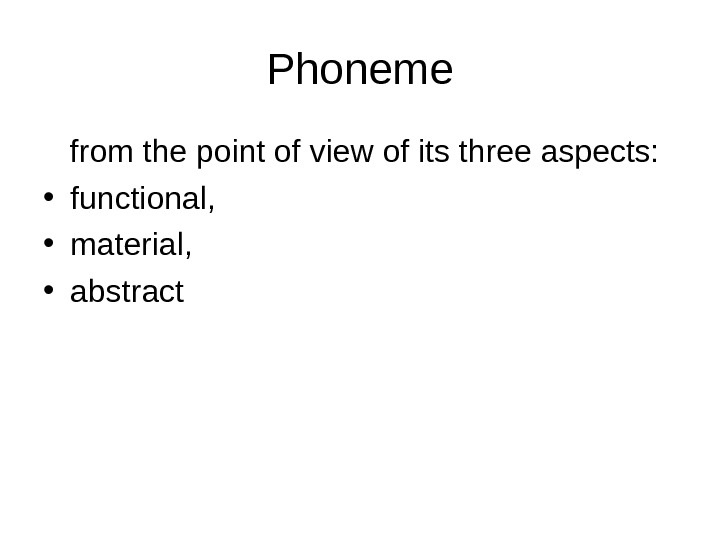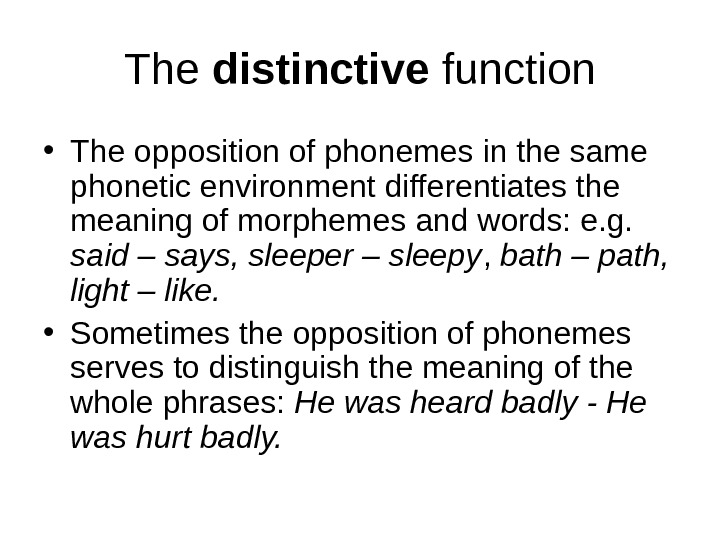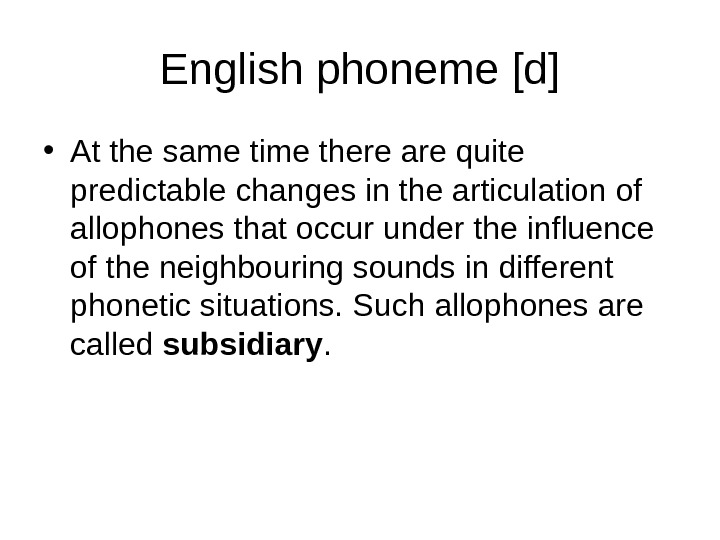Phoneme as a unit of language Phonology





































- Размер: 59 Кб
- Количество слайдов: 36
Описание презентации Phoneme as a unit of language Phonology по слайдам
 Phoneme as a unit of language
Phoneme as a unit of language
 Phonology • The branch of phonetics that studies the linguistic function of consonant and vowel sounds, syllabic structure, word accent and prosodic features, such as pitch, stress and tempo
Phonology • The branch of phonetics that studies the linguistic function of consonant and vowel sounds, syllabic structure, word accent and prosodic features, such as pitch, stress and tempo
 Function • discriminatory function → the role of the various elements of the language in the distinguishing of one sequence of sounds, such as a word or a sequence of words, from another of different meaning. • function of phonetic units → their role in the formation of syllables, words, phrases and even texts.
Function • discriminatory function → the role of the various elements of the language in the distinguishing of one sequence of sounds, such as a word or a sequence of words, from another of different meaning. • function of phonetic units → their role in the formation of syllables, words, phrases and even texts.
 History I. A. Baudouin-de-Courtenay • introduced functional or social aspect of phonetic phenomena N. S. Trubetskoy • declared phonology to be a linguistic science • limited articulatory and acoustic phonetics to anatomy, physiology and acoustics only. • This conception is shared by many foreign linguists → investigate the material form and the function of oral speech units separately.
History I. A. Baudouin-de-Courtenay • introduced functional or social aspect of phonetic phenomena N. S. Trubetskoy • declared phonology to be a linguistic science • limited articulatory and acoustic phonetics to anatomy, physiology and acoustics only. • This conception is shared by many foreign linguists → investigate the material form and the function of oral speech units separately.
 Soviet linguists • language being the man’s medium of thought can exist only in the material form of speech sounds → phonology a branch of phonetics that investigates its most important social aspect.
Soviet linguists • language being the man’s medium of thought can exist only in the material form of speech sounds → phonology a branch of phonetics that investigates its most important social aspect.
![“ Sound” can be interpreted in two rather different ways. • [t] and [d] are “ Sound” can be interpreted in two rather different ways. • [t] and [d] are](/docs//5_phoneme_as_a_unit_of_language_images/5_phoneme_as_a_unit_of_language_5.jpg) “ Sound” can be interpreted in two rather different ways. • [t] and [d] are two different sounds [t] – fortis and [d] – lenis tie — die, seat — seed • [t] in let us and [t] in let them → the two sounds are also not the same, [t] of let us is alveolar, while the [t] of let them is dental.
“ Sound” can be interpreted in two rather different ways. • [t] and [d] are two different sounds [t] – fortis and [d] – lenis tie — die, seat — seed • [t] in let us and [t] in let them → the two sounds are also not the same, [t] of let us is alveolar, while the [t] of let them is dental.
 “ Sound” • In both examples the sounds differ in one articulatory feature only • in the second case the difference between the sounds has functionally no significance. • It is perfectly clear that the sense of «sound» in these two cases is different.
“ Sound” • In both examples the sounds differ in one articulatory feature only • in the second case the difference between the sounds has functionally no significance. • It is perfectly clear that the sense of «sound» in these two cases is different.
 • » phoneme » is used to mean «sound» in its contrastive sense • » allophone » is used for sounds which are variants of a phoneme: they usually occur in different positions in the word (i. e. in different environments) and hence cannot contrast with each other, nor be used to make meaningful distinctions.
• » phoneme » is used to mean «sound» in its contrastive sense • » allophone » is used for sounds which are variants of a phoneme: they usually occur in different positions in the word (i. e. in different environments) and hence cannot contrast with each other, nor be used to make meaningful distinctions.
 Phoneme • a functional, material and abstract unit (L. V. Shcherba) • a dialectical unity of these aspects because they determine one another and are thus interdependent (V. A. Vassilyev)
Phoneme • a functional, material and abstract unit (L. V. Shcherba) • a dialectical unity of these aspects because they determine one another and are thus interdependent (V. A. Vassilyev)
 Phoneme • a minimal abstract linguistic unit realized in speech in the form of speech sounds opposable to other phonemes of the same language to distinguish the meaning of morphemes and words.
Phoneme • a minimal abstract linguistic unit realized in speech in the form of speech sounds opposable to other phonemes of the same language to distinguish the meaning of morphemes and words.
 Phoneme from the point of view of its three aspects: • functional, • material, • abstract
Phoneme from the point of view of its three aspects: • functional, • material, • abstract
 Firstly, • the phoneme is a functional unit: discriminatory function the role of the various components of the phonetic system → in distinguishing one morpheme from another, one word from another or also one utterance from another.
Firstly, • the phoneme is a functional unit: discriminatory function the role of the various components of the phonetic system → in distinguishing one morpheme from another, one word from another or also one utterance from another.
 The distinctive function • The opposition of phonemes in the same phonetic environment differentiates the meaning of morphemes and words: e. g. said – says, sleeper – sleepy , bath – path, light – like. • Sometimes the opposition of phonemes serves to distinguish the meaning of the whole phrases: He was heard badly — He was hurt badly.
The distinctive function • The opposition of phonemes in the same phonetic environment differentiates the meaning of morphemes and words: e. g. said – says, sleeper – sleepy , bath – path, light – like. • Sometimes the opposition of phonemes serves to distinguish the meaning of the whole phrases: He was heard badly — He was hurt badly.
 Secondly, • the phoneme is material, real and objective → it is realized in speech in the form of speech sounds, its allophones. • The phonemes constitute the material form of morphemes ↓ ↓ constitutive function
Secondly, • the phoneme is material, real and objective → it is realized in speech in the form of speech sounds, its allophones. • The phonemes constitute the material form of morphemes ↓ ↓ constitutive function
 Thirdly, • the phoneme is a material and objective unit as well as an abstract and generalized one at the same time • the use of the right allophones and other phonetic units facilitates normal recognition ↓ ↓ recognitive function
Thirdly, • the phoneme is a material and objective unit as well as an abstract and generalized one at the same time • the use of the right allophones and other phonetic units facilitates normal recognition ↓ ↓ recognitive function
 Types of allophones and the main features of the phoneme The sets of speech sounds → the allophones belonging to the same phoneme • are not identical in their articulatory content • though there remains some phonetic similarity between them.
Types of allophones and the main features of the phoneme The sets of speech sounds → the allophones belonging to the same phoneme • are not identical in their articulatory content • though there remains some phonetic similarity between them.
![English phoneme [d] • When not affected by the articulation of the preceding or following English phoneme [d] • When not affected by the articulation of the preceding or following](/docs//5_phoneme_as_a_unit_of_language_images/5_phoneme_as_a_unit_of_language_16.jpg) English phoneme [d] • When not affected by the articulation of the preceding or following sounds [d] is a plosive, forelingual apical, alveolar, lenis stop: door, darn, down, In this case the consonant [d] is called the principal allophone. • The allophones which do not undergo any distinguishable changes in the chain of speech are called principal.
English phoneme [d] • When not affected by the articulation of the preceding or following sounds [d] is a plosive, forelingual apical, alveolar, lenis stop: door, darn, down, In this case the consonant [d] is called the principal allophone. • The allophones which do not undergo any distinguishable changes in the chain of speech are called principal.
![English phoneme [d] • At the same time there are quite predictable changes in the articulation English phoneme [d] • At the same time there are quite predictable changes in the articulation](/docs//5_phoneme_as_a_unit_of_language_images/5_phoneme_as_a_unit_of_language_17.jpg) English phoneme [d] • At the same time there are quite predictable changes in the articulation of allophones that occur under the influence of the neighbouring sounds in different phonetic situations. Such allophones are called subsidiary.
English phoneme [d] • At the same time there are quite predictable changes in the articulation of allophones that occur under the influence of the neighbouring sounds in different phonetic situations. Such allophones are called subsidiary.
![English phoneme [d] • [d] is slightly palatalized before front vowels and the sonorant [j], e. English phoneme [d] • [d] is slightly palatalized before front vowels and the sonorant [j], e.](/docs//5_phoneme_as_a_unit_of_language_images/5_phoneme_as_a_unit_of_language_18.jpg) English phoneme [d] • [d] is slightly palatalized before front vowels and the sonorant [j], e. g. deal, day, did you • [d] is pronounced without any plosion before another stop, e. g. bedtime, bad pain, good dog • [d] it is pronounced with the nasal plosion before the nasal sonorants [n] and [m], e. g. sudden, admit, could not, could meet ; • the plosion is lateral before the lateral sonorant [l], e. g. middle, badly, bad light.
English phoneme [d] • [d] is slightly palatalized before front vowels and the sonorant [j], e. g. deal, day, did you • [d] is pronounced without any plosion before another stop, e. g. bedtime, bad pain, good dog • [d] it is pronounced with the nasal plosion before the nasal sonorants [n] and [m], e. g. sudden, admit, could not, could meet ; • the plosion is lateral before the lateral sonorant [l], e. g. middle, badly, bad light.
![• [d] becomes post-alveolar followed by [r], e. g. dry, dream ; • • [d] becomes post-alveolar followed by [r], e. g. dry, dream ; •](/docs//5_phoneme_as_a_unit_of_language_images/5_phoneme_as_a_unit_of_language_19.jpg) • [d] becomes post-alveolar followed by [r], e. g. dry, dream ; • [d] becomes dental followed by the interdental [θ], [ð], e. g. breadth, lead the way, good thing. • When [d] is followed by the labial [w] it becomes labialized, e. g. dweller. • In the initial position [d] is partially devoiced, e. g. dog, dean ; in the intervocalic position or when followed by a sonorant it is fully voiced, e. g. order, leader, driver ; in the word-final position it is voiceless, e. g. road, raised, old.
• [d] becomes post-alveolar followed by [r], e. g. dry, dream ; • [d] becomes dental followed by the interdental [θ], [ð], e. g. breadth, lead the way, good thing. • When [d] is followed by the labial [w] it becomes labialized, e. g. dweller. • In the initial position [d] is partially devoiced, e. g. dog, dean ; in the intervocalic position or when followed by a sonorant it is fully voiced, e. g. order, leader, driver ; in the word-final position it is voiceless, e. g. road, raised, old.
 • Consequently, though allophones of the same phoneme possess similar articulatory features they may frequently show considerable phonetic differences.
• Consequently, though allophones of the same phoneme possess similar articulatory features they may frequently show considerable phonetic differences.
 Allophones are arranged into functionally similar groups → groups of sounds in which • the members of each group are not opposed to one another, • are opposable to members of any other group to distinguish meanings in otherwise similar sequences.
Allophones are arranged into functionally similar groups → groups of sounds in which • the members of each group are not opposed to one another, • are opposable to members of any other group to distinguish meanings in otherwise similar sequences.
 Allophones • Consequently allophones of the same phoneme never occur in similar phonetic contexts, they are entirely predictable according to the phonetic environment, ↓ ↓ carry no useful information they cannot differentiate meanings
Allophones • Consequently allophones of the same phoneme never occur in similar phonetic contexts, they are entirely predictable according to the phonetic environment, ↓ ↓ carry no useful information they cannot differentiate meanings
![English phoneme [l] • the dark [ł] occurs following a vowel as in pill, cold English phoneme [l] • the dark [ł] occurs following a vowel as in pill, cold](/docs//5_phoneme_as_a_unit_of_language_images/5_phoneme_as_a_unit_of_language_23.jpg) English phoneme [l] • the dark [ł] occurs following a vowel as in pill, cold , but it is not found before a vowel • whereas the clear [l] only occurs before a vowel, as in lip, like. ↓ ↓ These two vowels cannot contrast with each other in the way that [I] contrasts with [r] in lip — rip or lake — rake there are no pairs of words which differ only in that one has [ł] and the other — [l].
English phoneme [l] • the dark [ł] occurs following a vowel as in pill, cold , but it is not found before a vowel • whereas the clear [l] only occurs before a vowel, as in lip, like. ↓ ↓ These two vowels cannot contrast with each other in the way that [I] contrasts with [r] in lip — rip or lake — rake there are no pairs of words which differ only in that one has [ł] and the other — [l].
 • The function of phonemes is to distinguish the meaning of morphemes and words. • Native speakers abstract themselves from the difference between the allophones of the same phoneme because it has no functional value ↓ ↓ do not realize that [d] is alveolar in dog , in dry it is post alveolar, in breadth it is dental
• The function of phonemes is to distinguish the meaning of morphemes and words. • Native speakers abstract themselves from the difference between the allophones of the same phoneme because it has no functional value ↓ ↓ do not realize that [d] is alveolar in dog , in dry it is post alveolar, in breadth it is dental
 Allophones of each phoneme possess a bundle of distinctive features, that makes this phoneme functionally different from all other phonemes of the language concerned.
Allophones of each phoneme possess a bundle of distinctive features, that makes this phoneme functionally different from all other phonemes of the language concerned.
 • This functionally relevant bundle of articulatory features is called the invariant of the phoneme. • Neither of the articulatory features that form the invariant of the phoneme can be changed without affecting the meaning.
• This functionally relevant bundle of articulatory features is called the invariant of the phoneme. • Neither of the articulatory features that form the invariant of the phoneme can be changed without affecting the meaning.
![All the allophones of the phoneme [d] • are occlusive, forelingual, lenis. • If occlusive All the allophones of the phoneme [d] • are occlusive, forelingual, lenis. • If occlusive](/docs//5_phoneme_as_a_unit_of_language_images/5_phoneme_as_a_unit_of_language_27.jpg) All the allophones of the phoneme [d] • are occlusive, forelingual, lenis. • If occlusive articulation is changed for constrictive one → [d] will be replaced by [z] breed — breeze, deal — zeal
All the allophones of the phoneme [d] • are occlusive, forelingual, lenis. • If occlusive articulation is changed for constrictive one → [d] will be replaced by [z] breed — breeze, deal — zeal
![• [d] will be replaced by [g] if the forelingual articulation is replaced by the • [d] will be replaced by [g] if the forelingual articulation is replaced by the](/docs//5_phoneme_as_a_unit_of_language_images/5_phoneme_as_a_unit_of_language_28.jpg) • [d] will be replaced by [g] if the forelingual articulation is replaced by the backlingual one, dear – gear, day- gay • The lenis articulation of [d] cannot be substituted by the fortis one because it will also bring about changes in meaning, dry — try, ladder — latter, bid — bit.
• [d] will be replaced by [g] if the forelingual articulation is replaced by the backlingual one, dear – gear, day- gay • The lenis articulation of [d] cannot be substituted by the fortis one because it will also bring about changes in meaning, dry — try, ladder — latter, bid — bit.
 That is why it is possible to state that occlusive, forelingual and lenis characteristics of the phoneme [d] are generalized in the mind of the speaker into what is called the invariant of this phoneme.
That is why it is possible to state that occlusive, forelingual and lenis characteristics of the phoneme [d] are generalized in the mind of the speaker into what is called the invariant of this phoneme.
 Distinctive or relevant articulatory features • To extract relevant feature of the phoneme we have to oppose it to some other phoneme in the same phonetic context. • If the opposed sounds differ in one articulatory feature and this difference brings about changes in the meaning of the words the contrasting features are called relevant.
Distinctive or relevant articulatory features • To extract relevant feature of the phoneme we have to oppose it to some other phoneme in the same phonetic context. • If the opposed sounds differ in one articulatory feature and this difference brings about changes in the meaning of the words the contrasting features are called relevant.
 • the words port and court differ in one consonant only ↓ initial consonant [p] and [k] Both sounds are occlusive and fortis, the only difference being that [p] is labial and [k] is backlingual. ↓ ↓ labial and backlingual articulations are relevant in the system of English consonants
• the words port and court differ in one consonant only ↓ initial consonant [p] and [k] Both sounds are occlusive and fortis, the only difference being that [p] is labial and [k] is backlingual. ↓ ↓ labial and backlingual articulations are relevant in the system of English consonants
 Non-distinctive, irrelevant or redundant articulatory features • do not serve to distinguish meaning an aspirated [p] ↔ a non-aspirated [p] ↓ ↓ aspiration is a non-distinctive feature of English consonants
Non-distinctive, irrelevant or redundant articulatory features • do not serve to distinguish meaning an aspirated [p] ↔ a non-aspirated [p] ↓ ↓ aspiration is a non-distinctive feature of English consonants
 Mistakes in the articulation L. V. Shcherba: pronunciation errors → • phonological • phonetic
Mistakes in the articulation L. V. Shcherba: pronunciation errors → • phonological • phonetic
 Phonological mistake • If an allopnone of some phoneme is replaced by an allophone of a different phoneme → the meaning of the word is inevitably affected. the vowel [i: ] in the word beat becomes slightly more open, more advanced or is no longer diphthongized beat → quite a different word bit.
Phonological mistake • If an allopnone of some phoneme is replaced by an allophone of a different phoneme → the meaning of the word is inevitably affected. the vowel [i: ] in the word beat becomes slightly more open, more advanced or is no longer diphthongized beat → quite a different word bit.
 Phonetic mistake • If an allophone of the phoneme is replaced by another allophone of the same phoneme. • It happens when the invariant of the phoneme is not modified and consequently the meaning of the word is not affected.
Phonetic mistake • If an allophone of the phoneme is replaced by another allophone of the same phoneme. • It happens when the invariant of the phoneme is not modified and consequently the meaning of the word is not affected.

